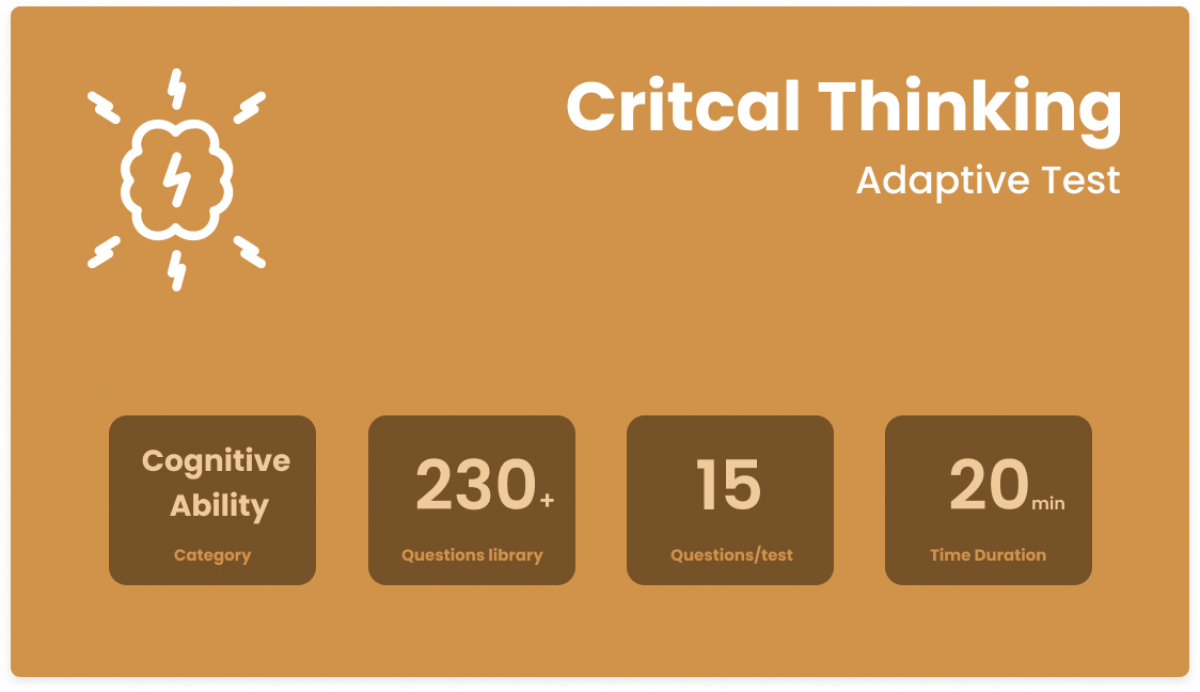Help Desk
Critical Thinking

About
The critical thinking test assesses the candidate’s ability to look at the premise and clearly understand it from multiple perspectives, separate facts from opinions and assumptions, analyze an argument and reach conclusions, develop and consider alternative explanations, and reason from incomplete patterns.
The test is an adaptive test that varies the difficulty of the questions based on the current performance of the candidate, thereby zeroing in on a fairly definitive numeric measure of the candidate. The result of this section is given in percentiles, relative to the whole test pool population of Merreo.
What does this section measure?
- Structured thinking
- Reasoning, Inferring, & Argumentation
- Basic understanding of the English language
Where to use this test?
The ultimate goal of this test is to measure the Critical thinking ability of candidates. But, at the same time, this test is a verbal one, also measure the English skills of the candidate. So this test is relevant in all places where you expect candidates to have excellent critical thinking and English skills.
For example,
- Business and Management roles
- Consulting roles
- Product management roles
This is a high-level test; high levels of literacy and English skills are required. Please avoid using this test for lower-level job openings. Also, don't use this test along with "English Intermediate". Please use our data-driven pre-sets for the best results.
Question Types
The critical thinking section has three types of questions evaluating 3 different aspects of critical thinking.
- Analytical critical reasoning
- Inference evaluation
- Argument evaluation
Analytical critical reasoning
Analytical critical reasoning type questions are designed to measure
• Reasoning from incomplete patterns
• Conditional reasoning
• Structured thinking
These types of questions have one prompt and 4 to 7 sub-questions. Each question will be a multiple-choice question with exactly one correct answer.
Example
There are exactly six groups in this year's Independence Day parade: Army, Navy, Air Force, Coast Guard, Special Forces, and Police force. Each group marches as a unit; the groups are ordered from first, at the front of the parade, to sixth, at the back. The following conditions apply:
- At least two groups march behind the Special Forces but ahead of the Coast Guard.
- Exactly one group marches behind the Army but ahead of the Police force.
- The Navy is the first, third, or fifth group.
Question 1) Which one of the following could be an accurate list of the groups in the Independence Day Parade in order from first to last?
A. Army, Special Forces, Police force, Coast Guard, Navy, Air Force
B. Navy, Special Forces, Air Force, Coast Guard, Army, Police force
C. Police force, Special Forces, Army, Navy, Air Force, Coast Guard
D. Air Force, Special Forces, Navy, Army, Coast Guard, Police force
E. Coast Guard, Police force, Air Force, Army, Navy, Special Forces
Answer - (D)
Explanation - List the possible order type
The first is to understand the constraints given in the question and apply them to the list. Then go with the process of elimination. Look for answers that deviate from the rules.
Answer choice (A): This answer is eliminated by the first rule. In this instance, there is only one group separating the Special Forces and Coast Guard.
Answer choice (B): This answer choice is eliminated by the third rule. In this answer, there is no group between Army and Police force
Answer choice (C): This answer is eliminated by the third rule because the Navy marches fourth.
Answer choice (D): This is the correct answer.
Answer choice (E): This answer violates both the first and second rules.
Question 2) If the Navy marched immediately ahead of the Police force, then which one of the following could be the fourth group?
A. Navy
B. Air Force
C. Coast Guard
D. Special Forces
E. Police force
Answer - (E)
Explanation – conditional reasoning type
This problem can be solved by constructing a template and fixing the confirmed places and possible places for the different groups
Answer choice (A): Under the condition in this question, the Navy must march third.
Answer choice (B): Under the condition in this question, Air Force must march fifth or sixth.
Answer choice (C): Under the condition in this question, Coast Guard must march fifth or sixth.
Answer choice (D): Under the condition in this question, Special Forces must march first.
Answer choice (E): This is the correct answer choice.
Inference Evaluation
An inference is a conclusion that you can draw from certain observed or supposed facts. But inferences may or may not be correct.
For example, you can infer that people are in the house by looking at whether the lights are up, but the people of the house might have left the light on and left the house. This inference is probably correct but not correct in all cases. Each question starts with a prompt that you have to treat as facts.
One must not bring in his/her previous knowledge or common sense when evaluating the inferences. All the questions will have the same 5 choices (True, probably true, Insufficient data, probably false, false).
True – When the inference is definitely true based on the prompt. The inference flows from the facts given
Probably True – When there are better chances of the inference being correct than being wrong based on the provided facts
Insufficient data – If you cannot decide anything about the inference. There is no basis to judge whether an inference could be probably true or probably false
Probably False - When there are better chances of the inference being false than being correct based on the provided facts
False – When the inference is definitely false. Inference contradicts or misinterprets the provided facts
Example,
Turkey is a surprising addition to the list of rapidly developing economies, with a GDP increase of 8.5%, in the year 2011 alone. However, such rapid growth leaves worry regarding possible side effects. For instance, in 2011 Turkey’s rate of inflation was well above that of its peers. Secondly, there is increasing concern regarding Turkey’s growing dependency on foreign capital. A large portion of the Turkish banking system is part-owned by banks in the Eurozone. As the single currency falters, such a dependency raises questions about the stability of Turkish growth.
Inference 1) There are concerns that Turkey’s development is at risk of faltering in years after 2011.
A. True
B. Probably true
C. Insufficient data
D. Probably false
E. False
Answer – True (A)
Because the information is explicitly stated in the prompt
Inference 2) As Turkish banks are part-owned by those in the Eurozone, they may suffer if the European banks face financial difficulty.
A. True
B. Probably true
C. Insufficient data
D. Probably false
E. False
Answer – Insufficient data (C)
The prompt says that if a European currency falters, the Turkish economy is in trouble, but there is no reason for us to believe that banks having financial troubles will destabilize the Turkish economy (there are a lot of reasons for a bank to face financial difficulty than just the currency faltering).
Argument Critical thinking
Argument critical thinking questions ask you to analyze a given argument and to recognize such things as factors that would strengthen or weaken the given argument. You have to analyze the reasoning errors committed to making that argument.
These types of questions come with a paragraph and a single question from it. The question will have five answer choices and only one will be correct.
Example,
Newspaper editorial – 5/12/18
Attempts to blame the Yorktown mayor’s policies for the growing inequality of wages are misguided. The sharp growth in the gap in earnings between college and high school graduates in this city during the past decade resulted from overall technological trends that favored the skills of more educated workers. The mayor’s response to this problem cannot be criticized, as it would hardly be reasonable to expect her to attempt to slow the forces of technology.
Question 1) Which of the following, reasons if true, casts the most serious doubt on the defense of the Yorktown Mayor by the author of this editorial?
A. Rather than cutting the education budget, the mayor could have increased the number of staff and funding devoted to locating employment for graduating high school seniors.
B. The mayor could have attempted to generate more demand for products from industries that paid high blue-collar wages.
C. The mayor could have initiated policies that would have made it easier for less-educated workers to receive the education necessary for better-paying jobs.
D. Instead of reducing the tax rate on the wealthiest earners, the mayor could have ensured that they shouldered a greater share of the total tax burden.
E. The mayor could have attempted to protect the earnings of city workers by instituting policies designed to reduce competition from foreign industries.
Answer – (C)
Explanation – The Author of this editorial claims that the Mayor has no fault in the happening and you must look for answers that reasonably claim that the mayor is at fault.
Answer choice (A) – This choice sidesteps the wage issue as more employment of high school graduates does not decrease the wage disparity.
Answer choice (B) – This choice utilizes “Blue-collar workers” interchangeably with “less educated” workers. This logical leap is not strongly warranted in the argument.
Answer choice (C) – This is the correct choice that directly goes against the conclusion of the argument. If the mayor could have implemented policies that made education more accessible, the less educated people could have become qualified for high qualified jobs that pay more. Hence the mayor could have mitigated the wage disparity.
Answer choice (D) – It only discusses the taxes and avoids discussing the wage issue. So this is irrelevant
Answer choice (E) – This choice is also irrelevant since it talks about the protection of wages of “city workers” and completely avoids discussing the wage issue.
Supported by:
